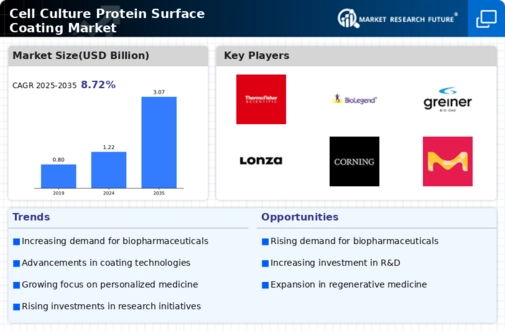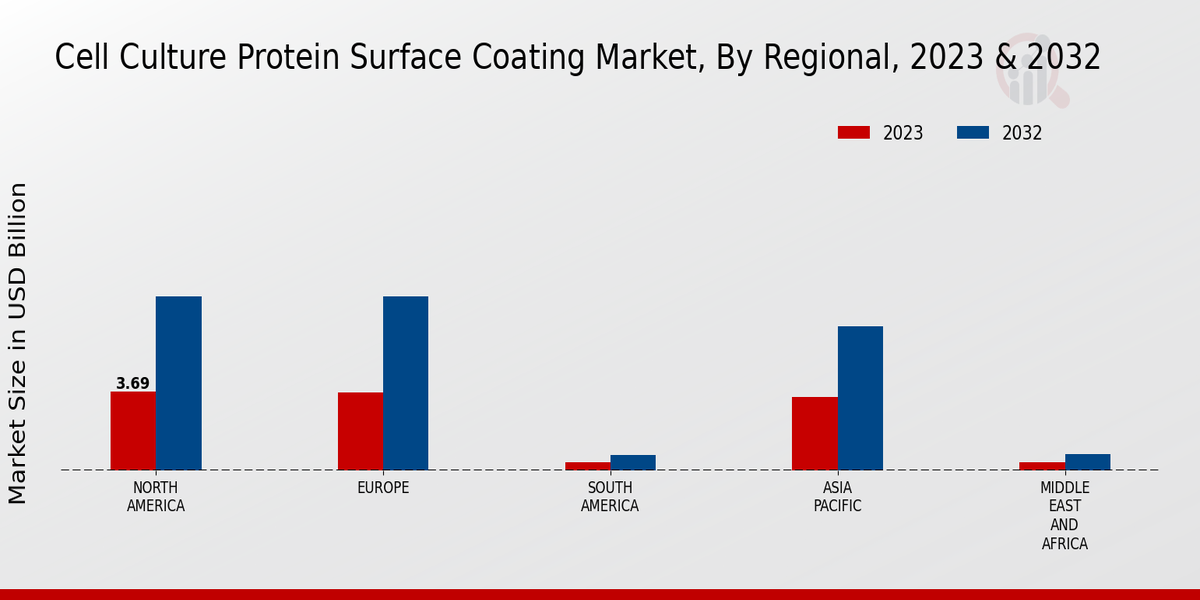Market Growth Projections
The Global Cell Culture Protein Surface Coating Market Industry is projected to experience substantial growth over the coming years. With an estimated market value of 1.22 USD Billion in 2024, the industry is expected to expand significantly, reaching approximately 3.07 USD Billion by 2035. This growth trajectory suggests a compound annual growth rate of 8.74% from 2025 to 2035. Such projections indicate a robust demand for innovative cell culture solutions, driven by advancements in biopharmaceuticals, research activities, and personalized medicine. The market's expansion reflects the increasing reliance on cell culture technologies across various applications.
Rising Demand for Biopharmaceuticals
The increasing demand for biopharmaceuticals is a primary driver of the Global Cell Culture Protein Surface Coating Market Industry. As the biopharmaceutical sector continues to expand, the need for effective cell culture techniques becomes paramount. Protein surface coatings enhance cell attachment and growth, which is essential for the production of therapeutic proteins. The market is projected to reach 1.22 USD Billion in 2024, reflecting the growing reliance on cell culture technologies in drug development and production. This trend indicates a robust growth trajectory, as the industry adapts to meet the evolving needs of biopharmaceutical manufacturers.
Growing Focus on Personalized Medicine
The growing emphasis on personalized medicine is influencing the Global Cell Culture Protein Surface Coating Market Industry. Personalized medicine relies on tailored therapeutic approaches that require precise cell culture techniques to ensure optimal outcomes. Protein surface coatings play a vital role in creating customized environments for cell growth, which is essential for developing patient-specific therapies. As healthcare systems shift towards personalized treatment modalities, the demand for innovative cell culture solutions is expected to rise. This trend aligns with the projected compound annual growth rate of 8.74% for the period from 2025 to 2035, indicating a robust market expansion.
Technological Advancements in Cell Culture
Technological advancements play a crucial role in shaping the Global Cell Culture Protein Surface Coating Market Industry. Innovations in surface coating materials and techniques enhance the efficiency and effectiveness of cell cultures. For instance, the development of novel biomaterials that mimic the extracellular matrix can significantly improve cell behavior and productivity. These advancements not only facilitate research but also streamline the manufacturing processes in various applications, including regenerative medicine and tissue engineering. As these technologies evolve, they are expected to contribute to the market's growth, with projections indicating a rise to 3.07 USD Billion by 2035.
Increased Research Activities in Life Sciences
The surge in research activities within the life sciences sector is a significant driver for the Global Cell Culture Protein Surface Coating Market Industry. Academic institutions and research organizations are increasingly investing in cell culture studies to explore new therapeutic avenues. This heightened focus on research necessitates the use of advanced cell culture techniques, including specialized protein surface coatings that enhance cell viability and functionality. As a result, the market is likely to experience sustained growth, supported by the continuous influx of funding and resources dedicated to life sciences research.
Regulatory Support for Cell Culture Technologies
Regulatory support for cell culture technologies is a pivotal factor driving the Global Cell Culture Protein Surface Coating Market Industry. Governments and regulatory bodies are increasingly recognizing the importance of cell culture in advancing biomedical research and therapeutic development. This support manifests in the form of streamlined approval processes and funding initiatives aimed at promoting innovation in cell culture techniques. Such regulatory frameworks not only facilitate market entry for new products but also encourage investment in research and development. As a result, the market is poised for growth, benefiting from favorable regulatory environments that stimulate technological advancements.
























Leave a Comment